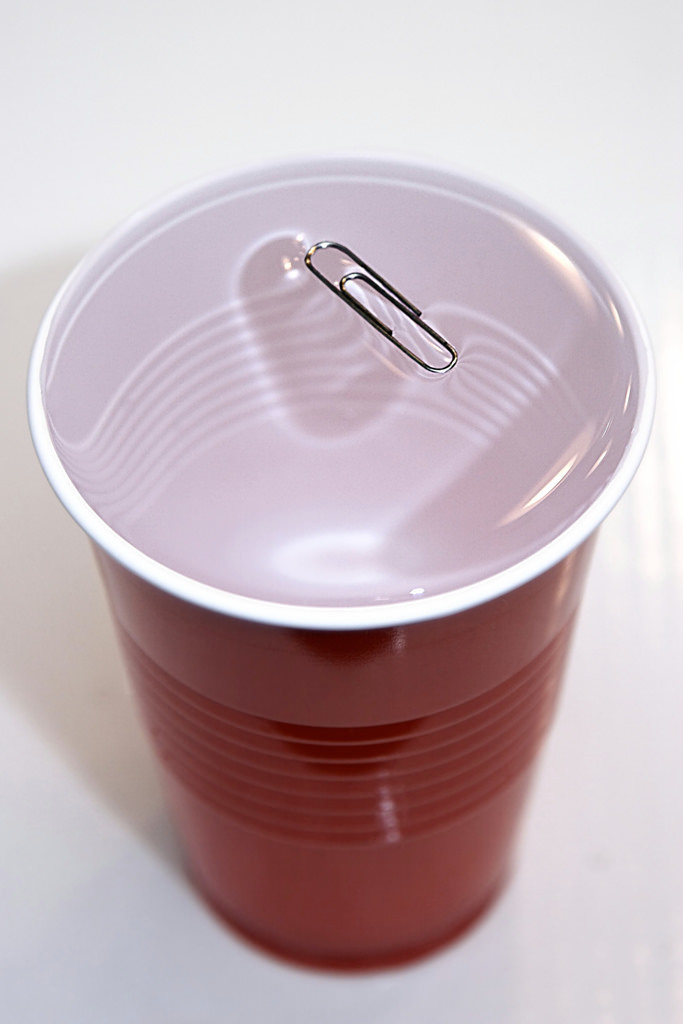Surface Tension
Surface tension, the amount of energy required to increase the surface area of a liquid, is a unique property determined by intermolecular forces.
Though the liquid phase takes on the shape of its container, water droplets often bead on a waxy or plastic surface, rather than forming the continuous thin layer that the standard properties of the liquid phase would predict.
Surface tension can create unexpected balances, allowing a solid object to sit on top of a lake or hot water to remove grease from a pan.
 Water droplets form because water molecules have a greater attraction to each other than to the other molecules surrounding them.[1]
Water droplets form because water molecules have a greater attraction to each other than to the other molecules surrounding them.[1]
Contents
A Molecular Explanation
Water molecules are attracted to each other by intermolecular forces like hydrogen bonds. A water molecule in the middle of a water droplet is being acted upon equally by all the neighboring water molecules, so there is no net force on the molecule. However, a molecule at the edge of the droplet is in contact with both water molecules and air molecules, and it is more strongly attracted to the other water molecules, exerting a net force that pulls the water molecules closer to each other, creating a stronger bond at the boundary with the air.
Surface tension is the amount of energy required to increase the surface area of a liquid by a certain amount. It is often measured in joules per square meter (\(J/m^2\)).
Two cars are sitting next to each other in a parking lot. The clean, shiny, newly-waxed hotrod has water droplets collecting on its hood, while the dirty pickup truck right next to it does not. Why the difference?
Why do water droplets form spheres?
 Water Strider [2]
Water Strider [2]
Water striders take advantage of surface tension to walk across ponds. Their long legs distribute their weight evenly, allowing these insects to only come in contact with the top layer of water, where the intermolecular bonds are strongest.
Other unique properties of liquids that depend on the nature of their intermolecular interactions are capillary action and viscosity.
Surfactants
A surfactant decreases the surface tension of the liquid to which it is added. Many surfactants are used as soaps or detergents, because they decrease the surface tension between water and incompatible substances like grease or oils.
 Photo from Flickr user chadh[3]
Photo from Flickr user chadh[3]
A classic demonstration of surface tension and surfactants involves filling a glass with water, then balancing a paperclip on the surface. After the paperclip is balanced, a drop of liquid soap can be added to the mixture, and the paperclip will sink to the bottom.
The human body also contains examples of surfactants. Bile salts are responsible for emulsifying fats in the intestinal tract.
The lungs also contain a surfactant. The lungs are elastic, allowing them to stretch and recoil. Lung compliance is a measure of how easily the lungs can stretch, and a larger lung compliance is good, because it correlates with less work required to take a breath. As the lung expands, so does the fluid layer lining the alveoli, which means that increased surface tension decreases lung compliance. The alveoli produce a natural surfactant (called pulmonary surfactant) to keep surface tension and lung compliance in balance. Premature infants often have underdeveloped lungs that do not yet produce surfactant, which can lead to respiratory distress syndrome if the infant is not given an exogenous form of the surfactant.
Why are lungs among the last organs to finish developing in a human fetus?
The lungs are involved in gas exchange (breathing). Fetuses are submerged in fluid and participate in gas exchange through the placenta and the mother's blood supply, so the lungs aren't used until after the baby is born.
References
- Pollack, G. Water Droplets on Water. Retrieved from https://commons.wikimedia.org/wiki/File:Water_Droplets_on_water.webm
- orestART, . Water Strider. Retrieved from https://www.flickr.com/photos/orestart/5286250264/
- chadh, . hydrogen bonds. Retrieved from https://www.flickr.com/photos/chadh-flickr/351100156/in/photolist-x2tQY